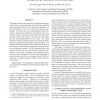Free Online Productivity Tools
i2Speak
i2Symbol
i2OCR
iTex2Img
iWeb2Print
iWeb2Shot
i2Type
iPdf2Split
iPdf2Merge
i2Bopomofo
i2Arabic
i2Style
i2Image
i2PDF
iLatex2Rtf
Sci2ools
ICASSP
2011
IEEE
2011
IEEE
Integrating binaural cues and blind source separation method for separating reverberant speech mixtures
This paper presents a new method for reverberant speech separation, based on the combination of binaural cues and blind source separation (BSS) for the automatic classification of the time-frequency (T-F) units of the speech mixture spectrogram. The main idea is to model interaural phase difference, interaural level difference and frequency bin-wise mixing vectors by Gaussian mixture models for each source and then evaluate that model at each T-F point and assign the units with high probability to that source. The model parameters and the assigned regions are refined iteratively using the Expectation-Maximization (EM) algorithm. The proposed method also addresses the permutation problem of the frequency domain BSS by initializing the mixing vectors for each frequency channel. The EM algorithm starts with binaural cues and after a few iterations the estimated probabilistic mask is used to initialize and re-estimate the mixing vector model parameters. We performed experiments on speec...
| Added | 20 Aug 2011 |
| Updated | 20 Aug 2011 |
| Type | Journal |
| Year | 2011 |
| Where | ICASSP |
| Authors | Atiyeh Alinaghi, Wenwu Wang, Philip J. B. Jackson |
Comments (0)

